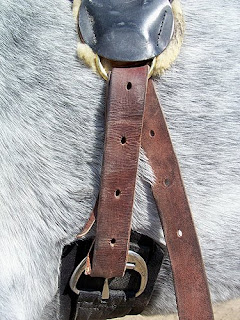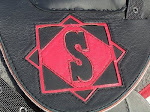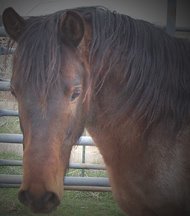I was planning to dress up as a cow. At dusk, I was going to head out to the paddocks and scare Aaruba's socks off. Can't you just see it? Naked from the knees down!
Alas, during last night's ride, he proved that the Bane of the Bovine has broken.
Many of you will recall that Aaruba has long suffered from a phobia of cows. Would you believe that there's an actual web page dedicated to cow phobia? I quote psychological trainer Jan Heering:
Phobia of cows is an intense condition of fright or dread of something, which does not have the power, or capacity of causing any sort of actual danger or threat.
I'll say it's intense.
The first and only time Aaruba ever reared under saddle was about a year ago, during one of his early rides outside the round corral. We'd just come upon a pasture full of Angus (henceforth known as Carnivorous Cows from Planet Horseflesh), and Aaruba spooked.
I misinterpreted the source of his terror and turned him the wrong direction, blocking his view of the monsters and causing him to panic. Up he went. This was no cute, little half rear. It was a full-on, release-the-reins, chest-to-mane, don't-move-a-muscle-lest-you-pull-him-over-backwards rear.
It's not nearly as much fun as the Lone Ranger pretends.
What is most pathetic is that most individuals are aware of the fact that their fear is unnatural or irrelevant but they are unable to escape the condition and feel terribly ashamed of themselves.
Hmm. Aaruba never indicated knowledge that his fear was irrational. He never demonstrated any shame. He certainly was pathetic, though. For months, I was obligated to dismount and lead him, bug-eyed and foaming, past every cow we met on our conditioning rides.
We live in farm country.
There are a lot of cows.
They are not only afraid to see a cow but the mere thought of they might see a cow horrifies them to such an extent that they suffer from panic attacks and ruthless anxiety.
Now we know what ails Aaruba. Cows are responsible for his gastric ulcers!Somebody order me a hamburger.
It is indeed unfortunate that cow phobia therapies require months and even years to show results and in the process, the victimized individual has to be exposed to the phobic condition repeatedly as part of the treatment.
Repeated exposure? Did that. And yes, it was unfortunate.
Ride after ride, I required Aaruba to pass fields of cows in hand. It was rather like leading a stick of dynamite by the fuse.
About 500 miles into the summer, I was able to ride, albeit very quickly, past the tiniest, sweetest, most doe-eyed Jersey calves. One at a time.
By 700 miles, we could pass a smattering of Holsteins, so long as they weren't grazing too near the fence, or mooing, or moving. Breathing was (usually) tolerable.
At the 800 mile mark, we charged up a hill past an entire herd of Angus. Aaruba seemed to be filled with helium and rocket fuel, but we survived. Just two miles up the road, we passed a feedlot lined with cows eating silage from a concrete ditch.
We didn't die.
It was a proud moment.
And then, there was last night. Last night, my friends, we passed a pasture brimming with yearling steers, a smattering of cows, and one fortunate bull. I shortened my reins and dropped my heels, waited for Aaruba's trotting legs to convert to pogo sticks. But, he simply sped up. A little.
Oh heavens above, I thought. Miracles happen!
And then...
Oh hell below, the herd is moving!
All two hundred head turned and walked as one in the same direction we were traveling, a great army of Carnivorous Cows from Planet Horseflesh rolling like tanks over the grass, wet noses glistening like fangs in the setting sun.
Three months ago, this turn of events would have sent Aaruba straight to Neptune, leaving me splattered like a skunk on the pavement.
But last night, Aaruba's courage prevailed. Pogo stick trot notwithstanding, we cleared the area in good form, all flaring nostrils and flagging tail. Hail the conquering hero!
Ms. Heering would have been proud.
Sadly, I'm still out of a Halloween costume. Any ideas? Maybe I could whip up a quick combine suit...
_____________________________________________
On another note, my November issue of Endurance News arrived today. The cover story is "What Your Horse's Urine Color Means." I think I'll leave this issue in the bathroom for our Thanksgiving guests. Why not? They already think I'm crazy.
_____________________________________________
Want to read more posts like this one? We deliver!






























